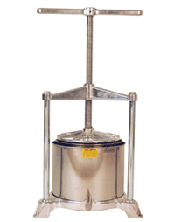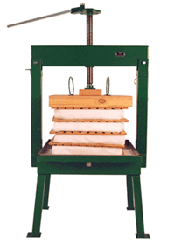Equipment - Pressing
Once the fruit is washed and milled (and for pears, macerated), then comes the fun bit. Pressing the fruit to extract the juice is essentially carried out by containing the fruit and applying pressure to it (squeezing it).
Once again, the size of press will depend on the quantity of juice you want to extract – and to some degree, the speed by which you want to extract the juice. Presses can range from table-top, single screw press to hydraulic rack and cloth presses, hydro press or belt press. Below is a brief explanation of the kind of thing you can get – follow the links to the side for companies that can supply them.
- Home made presses
There are a few places online where you can find details of how to squeeze the juice out of fruit using a home made press. The most popular, naturally, is the press design created by Ray Blockley (currently shown in the UKCider site, but hopefully soon to be found in a more detailed format on the Cider Workshop - thanks to Ray).
Other, more creative methods of pressing fruit include the use of a vice and some wooden/plastic boards; sitting the pomace in a hessian bag in a tray, placing a large board on the top and standing on it... you get the idea. If you come up with some ingenious new way of pressing fruit, do let us know!
- Table top presses (very small quantities)
These are entry level fruit presses, and are often using for wine making. Be careful when buying one of these, as the metal body may not be up to pressing the pomace of apples or pears very effectively.
- Basket presses
These are larger volume presses of a similar design to its table top cousins, although they are much more durable and can press much larger quantities. Vicky, our resident distributor, imports this style of press from Italy - so do compare.
- Rack and cloth presses
By far the most popular method of pressing apples, and also one of the more traditional methods. A frame with a heavy duty base, the pomace is formed in 'cheeses' (layers of pomace folded into cloths and with racks in between each cheese - see images). These cheeses are then pressed by applying pressure to a large block that sits on top of the cheeses.
These presses can vary in size and cost; generally from expensive to very expensive. However, Ray Blockleys press design has been used many times to produce a cheap and very effective version of a rack and cloth press.
- Hydro press (aka Bladder press)
Growing in popularity, and mainly available from Vigo, these use water to create the pressure required to press the pomace. General reports are that these are effective and clean
- Hydraulic presses (large quantities)
When pressing, often the pressure applied comes from either a screw (or multiple screws) that push on a block, or even a hydraulic car jack that does the same kind of thing. For larger quantities - where the amount of pomace is greater, electrically powered hydraulic arms deliver the pressure to extract the juice.
These presses are generally for commercial users and have a price tag to match. However, they are available as either rack and cloth or basket presses.
- Belt Presses
A more popular method of juice extraction for the commercial user, these continuously feed apple in smaller quantities along a conveyor, with something like mangle rollers doing the squeezing.
- Squeezeboxes
These are concertina presses, with a number of 'bags' which are hung vertically on a frame and then squeezed together. These are quicker to empty and clean than the rack and cloth equivalent, although are designed for the small to large commercial user.
Barry Topp, of New Forest Cider, successfully uses a Squeezebox, and the new lab at Hartpury have also invested in one. The are powerful and efficient (but not for the amateur!).
At the end of it, get the press you think you will need next year - although if you are increasing your cider making you will probably find that you get through several presses. However, as with fruit mills, presses are simple to resell (partly due to the cost of new ones). Check out ebay and also ask us in the group - we can at least let you know what kit we have and our experiences of it.

| There are many places that you can buy presses from. Below are just a few of the main manufacturers, and their online stores: |
If you can recommend any others, please let us know.
|
 |
Tabletop Press |
 |
Basket press |
 |
Rack and cloth press |
 |
Hydro press |
images from Vigo Ltd |

